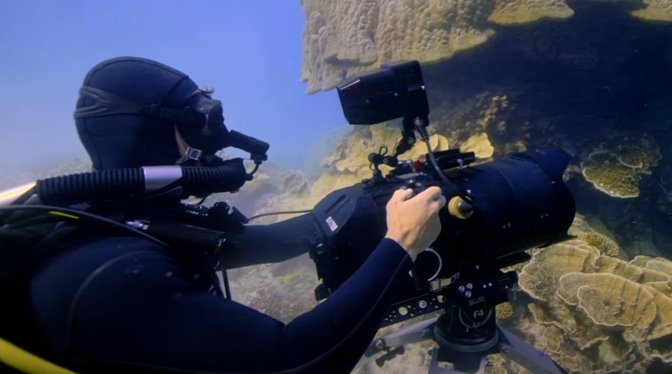Apple TV+ 'Tiny World' filmmakers used gas-retaining diving gear for underwater shots
To promote the second season of the Apple TV+ nature documentary "Tiny World," Apple has released a behind-the-scenes video showing the lengths its filmmakers took to capture the actions of small creatures underwater.

Narrated by Paul Rudd, "Tiny World" is a nature documentary series examining smaller creatures on Earth, including what they do to survive. To capture footage of the animals in their natural habitat, the filmmakers undertake considerable amounts of work to get the shots they need.
In a video posted to YouTube on Sunday, the behind-the-scenes video titled "Filming Inside the Reef" shows some of the equipment and techniques the show used to film underwater at the Great Barrier Reef.
As well as employing waterproof cameras and probe lenses to get close-up shots, the filmmakers had to use specialized diving equipment while filming. Rather than use traditional Scuba gear to stay underwater for a long period of time, alternate equipment that retained the gases was used, eliminating any bubbles or further disturbances of the water from the diver taking breaths.
"The animals are so much more comfortable around you, they're not scared off with every single exhale that you make," said camera operator Alex Vail, adding that it allowed the team to get closer to fish and other creatures.
The video also covers how the show recorded footage of the Peacock Mantis Shrimp, a creature that at one point attacked and broke a probe lens.
Apple previously released a behind-the-scenes video for the first season in October, showing the use of lenses intended for "scientific purposes" rather than the typical zoom lenses used by typical nature documentary teams. That video also revealed the use of a first-person-view drone, and a motion control rig to film a gecko over three years.
The second season of "Tiny World," made up of six episodes, is available to watch now on Apple TV+.

Narrated by Paul Rudd, "Tiny World" is a nature documentary series examining smaller creatures on Earth, including what they do to survive. To capture footage of the animals in their natural habitat, the filmmakers undertake considerable amounts of work to get the shots they need.
In a video posted to YouTube on Sunday, the behind-the-scenes video titled "Filming Inside the Reef" shows some of the equipment and techniques the show used to film underwater at the Great Barrier Reef.
As well as employing waterproof cameras and probe lenses to get close-up shots, the filmmakers had to use specialized diving equipment while filming. Rather than use traditional Scuba gear to stay underwater for a long period of time, alternate equipment that retained the gases was used, eliminating any bubbles or further disturbances of the water from the diver taking breaths.
"The animals are so much more comfortable around you, they're not scared off with every single exhale that you make," said camera operator Alex Vail, adding that it allowed the team to get closer to fish and other creatures.
The video also covers how the show recorded footage of the Peacock Mantis Shrimp, a creature that at one point attacked and broke a probe lens.
Apple previously released a behind-the-scenes video for the first season in October, showing the use of lenses intended for "scientific purposes" rather than the typical zoom lenses used by typical nature documentary teams. That video also revealed the use of a first-person-view drone, and a motion control rig to film a gecko over three years.
The second season of "Tiny World," made up of six episodes, is available to watch now on Apple TV+.


Comments
Basic rebreathers work on air and just sequester carbon dioxide from what you exhale. They're not really safe for diving, but are sometimes used as emergency escape equipment in industrial situations. For example, if you have a fire suppressant system which works by sealing a room and extracting oxygen from it, low-end rebreathers like this are common safety gear placed on pillars in the facility.
Units suitable for diving add some oxygen back to the loop. The time on these is limited mostly by the capacity of the oxygen tank, and to a lesser extent by the capacity of the system as a whole to deal with gas expansion. These are also used for firefighting and surgical anesthesia.
Some rebreather designs work on a pure-oxygen loop, which simplifies a lot of things, but pure oxygen is toxic at high pressures, so they're only good down to 20 feet or so. They work beautifully in space, though, as running a space suit with pure oxygen means you can run it at a much lower pressure, meaning the joints don't fight the user as much.